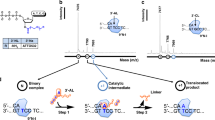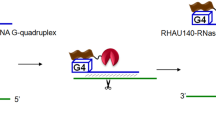Abstract
A method to purify enzymes utilizing their specific biological affinity and catalytic specificity is described. For this chromatographic technique, an enzyme binds immobilized substrate coupled to a column in the absence of a cofactor required for catalysis but permissive for substrate binding. After washing, the missing cofactor is added to the column mobile phase, and the enzyme converts substrate into product and elutes from the column. A single-step purification of EcoRI endonuclease using a sequence-specific DNA column (containing the GAATTC motif coupled to cyanogen bromide-activated Sepharose 4B) binds EcoRI in the absence of Mg2+ and elutes when Mg2+ is applied in a highly purified state. Although the method described is specific for EcoRI, it can be readily modified for the purification of DNA polymerases and other enzymes. Furthermore, many of the same materials are also used for transcription factor purification. This protocol can be completed within 4–6 d.
This is a preview of subscription content, access via your institution
Access options
Subscribe to this journal
Receive 12 print issues and online access
$259.00 per year
only $21.58 per issue
Buy this article
- Purchase on Springer Link
- Instant access to full article PDF
Prices may be subject to local taxes which are calculated during checkout





Similar content being viewed by others
References
Axen, R., Porath, J. & Ernback, S. Chemical coupling of peptides and proteins to polysaccharides by means of cyanogen halides. Nature 214, 1302–1304 (1967).
Alberts, B. & Herrick, G. DNA-cellulose chromatography. Meth. Enzymol. 21, 198–217 (1971).
Alberts, B.M., Amodio, F.J., Jenkins, M., Gutmann, E.D. & Ferris, F.L. Studies with DNA-cellulose chromatography. I. DNA-binding proteins from Escherichia coli. Cold Spring Harb. Symp. Quant. Biol. 33, 289–305 (1968).
Jovin, T.M. & Kornberg, A. Polynucleotides celluloses as solid state primers and templates for polymerases. J. Biol. Chem. 243, 250–259 (1968).
Litman, R.M. A deoxyribonucleic acid polymerase from Micrococcus luteus (Micrococcus lysodeikticus) isolated on deoxyribonucleic acid-cellulose. J. Biol. Chem. 243, 6222–6233 (1968).
Arndt-Jovin, D.J., Jovin, T.M., Bahr, W., Frischauf, A.-M. & Marquardt, M. Covalent attachment of DNA to agarose. Improved synthesis and use in affinity chromatography. Eur. J. Biochem. 54, 411–418.
Kadonaga, J.T. & Tjian, R. Affinity purification of sequence-specific DNA binding proteins. Proc. Natl. Acad. Sci. USA. 83, 5889–5893 (1986).
Kadonaga, J.T. Purification of sequence-specific binding proteins by DNA affinity chromatography. Meth. Enzymol. 208, 10–23 (1991).
Moxley, R.A., Oak, S.A., Gadgil, H. & Jarrett, H.W. in Handbook of Affinity Chromatography (ed. Hago, D.) 173–214 (Francis & Taylor, New York, 2005).
Gadgil, H., Jurado, L.A. & Jarrett, H.W. DNA affinity chromatography of transcription factors. Anal. Biochem. 290, 147–178 (2000).
Gallop, P.M., Seifter, S. & Meilman, E. Studies on collagen. I. The partial purification, assay and mode of activation of bacterial collagenase. J. Biol. Chem. 227, 891–906 (1957).
Jurado, L.A., Drummond, J.T. & Jarrett, H.W. Catalytic chromatography. Anal. Biochem. 282, 39–45 (2000).
Mitra, S., Jarrett, H.W. & Jurado, L.A. High-performance catalytic chromatography (HPCC): the adapter approach. J. Chromatogr. A 1076, 71–82 (2005).
Modrich, P. & Zabel, D. EcoRI endonuclease. Physical and catalytic properties of the homogenous enzyme. J. Biol. Chem. 251, 5866–5874 (1976).
Gadgil, H. & Jarrett, H.W. Oligonucleotide trapping method for purification of transcription factors. J. Chromatogr. A 966, 99–110 (2002).
Moxley, R.A. & Jarrett, H.W. Oligonucleotide trapping method for transcription factor purification systematic optimization using electrophoretic mobility shift assay. J. Chromatogr. A 1070, 23–34 (2005).
Jiang, D., Moxley, R.A. & Jarrett, H.W. Promoter trapping of c-jun promoter-binding transcription factors. J. Chromatogr. A 1133, 83–94 (2007).
Author information
Authors and Affiliations
Corresponding author
Ethics declarations
Competing interests
The authors declare no competing financial interests.
Rights and permissions
About this article
Cite this article
Nagore, L., Mitra, S., Jiang, D. et al. Cyanogen bromide-activated coupling: DNA catalytic chromatography purification of EcoRI endonuclease. Nat Protoc 1, 2909–2915 (2006). https://doi.org/10.1038/nprot.2006.439
Published:
Issue Date:
DOI: https://doi.org/10.1038/nprot.2006.439
This article is cited by
-
Regulation of GAD65 expression by SMAR1 and p53 upon Streptozotocin treatment
BMC Molecular Biology (2012)
Comments
By submitting a comment you agree to abide by our Terms and Community Guidelines. If you find something abusive or that does not comply with our terms or guidelines please flag it as inappropriate.



